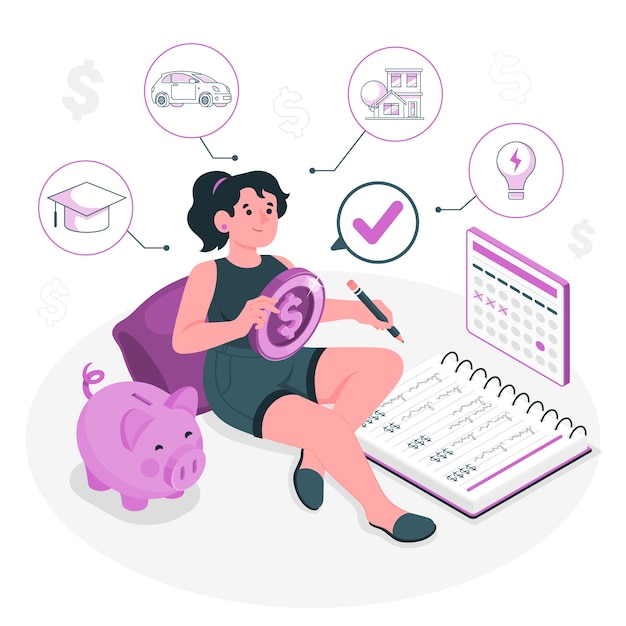
Putting money aside isn’t always straightforward, especially when funds are scarce, however, it reaps benefits in the long run. It’s particularly beneficial to establish a sturdy savings base as a safeguard against potential economic downturns or any kind of emergency. In this article, we’ll discuss several techniques to assist you in reaching your financial objectives.
Why should you prioritize a savings strategy? There are several compelling reasons why:
Financial Stability: With a savings plan in place, you can create a financial lifeline. Savings can aid in managing unforeseen costs such as medical emergencies, vehicle repairs, or loss of employment.
Emergency Preparedness: Savings can provide you with a contingency plan for emergencies. Having savings enables you to handle unexpected situations without resorting to credit cards or loans.
Realizing Goals: Whether it comes to buying a house, starting a business, or pursuing that dream vacation, a savings strategy can get you there. It provides the resources needed to turn your dreams into reality.
Peace of Mind: Knowing you have a nest egg can alleviate financial stress and give you the freedom to concentrate on other aspects of your life.
Independence and Flexibility: Savings can provide financial freedom, enabling you to make decisions based on your personal choice rather than just immediate financial considerations.
SIX SAVING STRATEGIES YOU MIGHT NOT HAVE CONSIDERED
When it comes to developing a robust savings base, even small adjustments can accumulate quickly. Here are six strategies you could start applying immediately to save money.
AUTOMATIC TRANSFERS
Establishing an automatic savings plan means you’re putting away some of your income every month without the effort of remembering to transfer funds. This method can be especially beneficial when your savings accounts are reserved for specific objectives, like creating an emergency fund, planning a vacation, or accumulating a down payment.
Nearly all banks provide automatic transfers between your checking and savings accounts. You can decide the timing, amount, and destination for the transfers, or even divide your direct deposit so part of every paycheck goes directly into your savings account. The advantage: it doesn’t require any effort and you’re less likely to spend the money instead.
LOWER RESTAURANT EXPENDITURE
One of the simplest expenses to curtail when you’re trying to save more is restaurant costs, as eating out tends to be costlier than cooking at home. If you still wish to eat out occasionally, try to diminish the frequency, or allocate a small portion of your monthly budget for it.
Choosing appetizers or sharing an entrée with your dining partner can also be cost-effective strategies. Avoiding drinks or dessert or indulging in these at home after dining out can further optimize your budget.
IMPLEMENTING THE 30-DAY RULE
Enforcing a 30-day savings rule is a straightforward strategy that can minimize impulse buying and boost your savings. The rule simply indicates a waiting period between the moment you spot an item and when you actually buy it.
Consider placing the item in your online basket and leaving it there until you’ve had more time to contemplate the purchase. If 30 days feels too long, you can adopt shorter periods such as a 24- or 48-hour delay.
REDUCE YOUR ELECTRIC BILL
Simple measures can result in significant savings on utilities. By being aware of how you’re using energy in your home, you can make decisions to reduce consumption and save money. Simple actions, such as turning off lights when leaving a room or making your laundry process more energy-efficient, can make a difference.
Consider insulating your home more effectively, using smart power strips, replacing old appliances with energy-saving ones, and switching to a smart thermostat. Even minor reductions in your monthly electricity usage can lead to large savings in the long run.
SETTLE HIGH-INTEREST DEBT
Deciding how much money to allocate towards savings versus settling debt is a common financial dilemma. Debt payments can put enormous stress on your budget. If you can manage to pay off high-interest debt faster through making extra payments, you’ll save in total interest and be free of that burden sooner.
Once you’ve paid off a debt, you can start channeling that money into savings instead. If you don’t have disposable income for extra payments, think about picking up an additional part-time job to earn extra cash.
ATTEMPT A NO-SPEND MONTH
A no-spend month involves challenging yourself to eliminate non-essential spending for a period of one month. This means cutting out any unnecessary outgoings and living more frugally. The only money spent during this month would be on essentials.
Just ensure clear guidelines are established upfront (what you will and won’t purchase). Accountability is key, therefore, having a friend take on the challenge with you can be beneficial.
CONCLUSION
Creating a strong savings base is an essential pillar of your financial well-being. It ensures security, flexibility, a safety net against unpredictable expenses, and the resources to attain your financial aspirations. Don’t hesitate to test out these strategies and find what fits your lifestyle and financial objectives. Remember, saving is a progressive journey, and modest changes can lead to substantial results over time. As you develop a savings habit, you’ll integrate effective money-management practices into your lifestyle.


